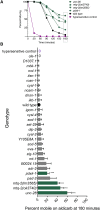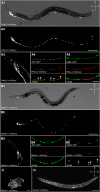Systematic Functional Characterization of Human 21st Chromosome Orthologs in Caenorhabditis elegans
- PMID: 29367452
- PMCID: PMC5844316
- DOI: 10.1534/g3.118.200019
Systematic Functional Characterization of Human 21st Chromosome Orthologs in Caenorhabditis elegans
Abstract
Individuals with Down syndrome have neurological and muscle impairments due to an additional copy of the human 21st chromosome (HSA21). Only a few of ∼200 HSA21 genes encoding proteins have been linked to specific Down syndrome phenotypes, while the remainder are understudied. To identify poorly characterized HSA21 genes required for nervous system function, we studied behavioral phenotypes caused by loss-of-function mutations in conserved HSA21 orthologs in the nematode Caenorhabditis elegans We identified 10 HSA21 orthologs that are required for neuromuscular behaviors: cle-1 (COL18A1), cysl-2 (CBS), dnsn-1 (DONSON), eva-1 (EVA1C), mtq-2 (N6ATM1), ncam-1 (NCAM2), pad-2 (POFUT2), pdxk-1 (PDXK), rnt-1 (RUNX1), and unc-26 (SYNJ1). We also found that three of these genes are required for normal release of the neurotransmitter acetylcholine. This includes a known synaptic gene unc-26 (SYNJ1), as well as uncharacterized genes pdxk-1 (PDXK) and mtq-2 (N6ATM1). As the first systematic functional analysis of HSA21 orthologs, this study may serve as a platform to understand genes that underlie phenotypes associated with Down syndrome.
Keywords: Down syndrome; neurological; neuromuscular; synaptic.
Copyright © 2018 Nordquist et al.
Figures







Similar articles
-
Survey of Human Chromosome 21 Gene Expression Effects on Early Development in Danio rerio.G3 (Bethesda). 2018 Jul 2;8(7):2215-2223. doi: 10.1534/g3.118.200144. G3 (Bethesda). 2018. PMID: 29760202 Free PMC article.
-
The Caenorhabditis elegans ortholog of C21orf80, a potential new protein O-fucosyltransferase, is required for normal development.Genomics. 2004 Aug;84(2):320-30. doi: 10.1016/j.ygeno.2004.04.002. Genomics. 2004. PMID: 15233996
-
Mouse models of Down syndrome: gene content and consequences.Mamm Genome. 2016 Dec;27(11-12):538-555. doi: 10.1007/s00335-016-9661-8. Epub 2016 Aug 18. Mamm Genome. 2016. PMID: 27538963 Free PMC article. Review.
-
Human amyloid β peptide and tau co-expression impairs behavior and causes specific gene expression changes in Caenorhabditis elegans.Neurobiol Dis. 2018 Jan;109(Pt A):88-101. doi: 10.1016/j.nbd.2017.10.003. Epub 2017 Oct 2. Neurobiol Dis. 2018. PMID: 28982592
-
Gene therapy for Down syndrome.Prog Brain Res. 2012;197:237-47. doi: 10.1016/B978-0-444-54299-1.00012-1. Prog Brain Res. 2012. PMID: 22541296 Review.
Cited by
-
Differential regulation of degradation and immune pathways underlies adaptation of the ectosymbiotic nematode Laxus oneistus to oxic-anoxic interfaces.Sci Rep. 2022 Jun 13;12(1):9725. doi: 10.1038/s41598-022-13235-9. Sci Rep. 2022. PMID: 35697683 Free PMC article.
-
Survey of Human Chromosome 21 Gene Expression Effects on Early Development in Danio rerio.G3 (Bethesda). 2018 Jul 2;8(7):2215-2223. doi: 10.1534/g3.118.200144. G3 (Bethesda). 2018. PMID: 29760202 Free PMC article.
-
APOE4-induced patterned behavioral decline and neurodegeneration requires endogenous tau in a C. elegans model of Alzheimer's disease.bioRxiv [Preprint]. 2025 May 15:2025.05.06.652574. doi: 10.1101/2025.05.06.652574. bioRxiv. 2025. PMID: 40463229 Free PMC article. Preprint.
-
Downregulating EVA1C exerts the potential to promote neuron growth after neonatal hypoxic-ischemic encephalopathy injury associated with alternative splicing.Ibrain. 2022 Jul 21;8(4):481-491. doi: 10.1002/ibra.12053. eCollection 2022 Winter. Ibrain. 2022. PMID: 37786591 Free PMC article.
-
Replisome genes regulation by antitumor miR-101-5p in clear cell renal cell carcinoma.Cancer Sci. 2020 Apr;111(4):1392-1406. doi: 10.1111/cas.14327. Epub 2020 Feb 22. Cancer Sci. 2020. PMID: 31975570 Free PMC article.
References
-
- Ahn K.-J., Jeong H. K., Choi H.-S., Ryoo S.-R., Kim Y. J., et al. , 2006. DYRK1A BAC transgenic mice show altered synaptic plasticity with learning and memory defects. Neurobiol. Dis. 22: 463–472. - PubMed
-
- Albertson D. G., Thomson J. N., 1976. The pharynx of Caenorhabditis elegans. Philos. Trans. R. Soc. Lond. B Biol. Sci. 275: 299–325. - PubMed
-
- Altafaj X., Dierssen M., Baamonde C., Martí E., Visa J., et al. , 2001. Neurodevelopmental delay, motor abnormalities and cognitive deficits in transgenic mice overexpressing Dyrk1A (minibrain), a murine model of Down’s syndrome. Hum. Mol. Genet. 10: 1915–1923. - PubMed
-
- Antonarakis S. E., 2016. Down syndrome and the complexity of genome dosage imbalance. Nat. Rev. Genet. 18: 147–163. - PubMed
Publication types
MeSH terms
Substances
Grants and funding
LinkOut - more resources
Full Text Sources
Other Literature Sources
Medical
Research Materials
Miscellaneous
